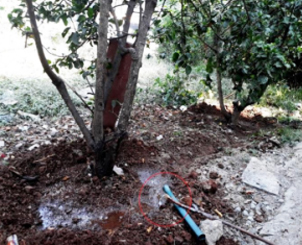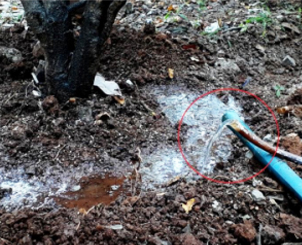
In many locations where the available supply of fresh water has become inadequate to meet water needs, it is clear that the once-used water collected from communities and municipalities must be viewed not as a waste to be disposed off but as a resource that must be reused. Because of health and safety concerns, water reuse applications are mostly restricted to non-potable uses such as landscape and agriculture irrigation. Plans are proceeding slowly towards groundwater recharge for repelling saltwater intrusion and towards the reuse in non-potable industrial applications (e.g. boiler water and cooling tower.)
Wastewater when recycled can be used to irrigate fields, sustain industrial activity and even create drinking water. Reuse can reduce the amount of freshwater required for these applications and decrease diversion of water from sensitive ecosystems.
In the process of distillation vapors passing through the condenser tube are cooled and condensed by water flowing through condenser tube in the condenser unit of the apparatus. In almost all laboratories the water used for cooling the condenser tube is coming from the water supply tap near the wash basin. The precious water after circulating through the condenser tube is left into the drain as wastewater. It has been observed that about 40 liters of water is required for cooling for making 500 ml of distilled water. The water after cooling is generally left to go into the drain.
Organic reactions run faster at higher temperatures and slower at lower temperatures. Many reactions commonly run in an organic laboratory need to be heated in order to proceed at a satisfactory rate. The most convenient way to heat a reaction is by boiling it in a solvent in a conical vial or round bottom flask. It is easy to observe whether or not a liquid is boiling, and because of the laws of thermodynamics, once boiling begins the temperature cannot rise any higher. To control the temperature of the reaction, simply choose a solvent with a boiling point at this temperature.
To prevent the solvent from boiling away, a reflux condenser is used. This is a glass column with a second column surrounding it through which cool water flows. As vapor from the boiling solvent rises into inside column of the reflux condenser, it is cooled by the jacket of water on the outside and condenses. It then falls back into the solution. In this way, you can maintain a reaction at the boiling point of the solvent indefinitely, as long as the water in the reflux condenser is cool enough to condense the entire vapor. Any time you heat a liquid, you should always stir it to avoid bumping. Bumping occurs when only the liquid at the very bottom is hot enough to boil, and it builds up pressure and bursts suddenly, sometimes spattering out of the container. The reflux condenser is open at the top to prevent pressure build-up.
COD (Chemical oxygen demand) often is used as a measurement of pollutants in wastewater and natural waters. The COD method determines the quantity of oxygen required to oxidize the organic matter in a waste sample, under specific conditions of oxidizing agent, temperature, and time. Principle of COD is to oxidize organic matter by a boiling mixture of chromic and sulfuric acids. A sample is refluxed in strongly acid solution with a known excess of potassium dichromate (K2Cr2O7). After digestion, the remaining unreduced K2Cr2O7 is titrated with ferrous ammonium sulfate to determine the amount of K2Cr2O7 consumed and the oxidizable matter is calculated in terms of oxygen equivalent. Open reflux method is suitable for wide range of sample.
Procedure
1. To reflux a reaction, add all of the reagents (COD test) to a conical round bottom flask as directed. Add a spin vane or a spin bar (round bottom flask) and top it with the reflux condenser, securing it with a clamp.
2. Attach tubing to the condenser so that water continuously flows from the tap into the bottom of the condenser, and out of the top and into the drain. (If you attach the tubing backwards, the water will just run down part of the inside of the condenser instead of filling it up, and won't do a good job of cooling.)
3. Turn on the stirrer and the water to be moving through the condenser fast enough to cool the vapor and then gradually heat the reaction until solvent refluxing. Liquid forming (solvent) in the condenser is flowing back into the reaction. It may appear as droplets or as a continuous stream.
4. When finished refluxing, allow the reaction to cool, turn off the water, remove the spin vane with forceps, and proceed with the instructions. Be patient while waiting for it to cool.

For complete digestion this process required two and half hours. Water plays important role in cooling the condenser. If the tubing is backwards water run inside the tube and not get good cooling effect. To get better cooling effect water must be go inside from bottom and out from top of the condenser.
Here we worked on this come out water from top and analyze some parameters like pH and temperature. We do not found significant changes in this parameter. We calculate flow of water coming out from top of condenser using 1000 ml measuring cylinder. Finally we use this water for gardening in front of our laboratory at Gokul dairy.
1 lt. per 1 min.
For 2 and 1/2 hr. 90 lt.
For cooling 30 min. 30 lt.
It's mean that we used 120 lt. water in one shift (8 hr.) here we analyze COD in 3 shift that means 360 lt. in 1day and 10,800 lt. water in 1 month.
Result
From above calculation it is found that initial we were waste 10,800 lt. water per month. By taking small steps towards water conservation now we save and reuse that much quantity of water for gardening in front of our laboratory.
Also we thinking reuse of water used at the time of distilled water preparation. This water may be use for cleaning and washing of glassware's and dishes.


Your email address will not be published. Required fields are marked *